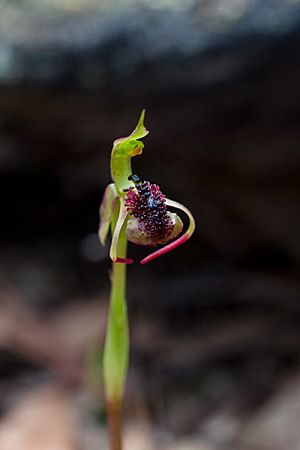Long-clubbed wasp orchid facts for kids
Quick facts for kids Long-clubbed wasp orchid |
|
|---|---|
 |
|
| Scientific classification | |
| Synonyms | |
|
The Chiloglottis trilabra, also known as the long-clubbed wasp orchid, is a special type of orchid. It grows only in south-eastern Australia. This orchid has two dark green leaves. It produces a single greenish-brown or pinkish flower. A unique feature is its dark red to black, ant-like callus on the flower's lip. This orchid looks quite similar to two other orchids, C. seminuda and C. reflexa.
Contents
What Does the Long-Clubbed Wasp Orchid Look Like?
The long-clubbed wasp orchid is a perennial plant. This means it lives for more than two years. It is also a deciduous herb, losing its leaves each year. It has two dark green leaves that are shaped like an egg. These leaves are about 20 to 50 mm (0.8 to 2 inches) long and 10 to 15 mm (0.4 to 0.6 inches) wide.
The Flower's Features
A single flower grows on a stem that is about 50 to 100 mm (2 to 4 inches) tall. The flower itself is greenish-brown or pinkish. It measures about 25 to 32 mm (1 to 1.3 inches) long and 6 to 7 mm (0.2 to 0.3 inches) wide.
- The dorsal sepal (the top part of the flower) is shaped like a spatula. It is about 13 to 16 mm (0.5 to 0.6 inches) long. It has a tiny tip that looks like a gland.
- The lateral sepals (the side parts) are thin and curve downwards. They are about 15 to 18 mm (0.6 to 0.7 inches) long. They also have dark red, glandular tips.
- The petals are oblong (oval-shaped) and turn downwards. They are about 9 to 11 mm (0.35 to 0.43 inches) long.
- The labellum is the orchid's special lip. It is diamond-shaped and about 9 to 11 mm (0.35 to 0.43 inches) long. Most of its top surface is covered by a black, ant-like callus. This callus is surrounded by many small glands.
- The column (the central part of the flower) has narrow wings.
This orchid usually flowers from December to March.
How it Compares to Similar Orchids
The long-clubbed wasp orchid is similar to C. seminuda. However, C. seminuda has a callus that covers only about two-thirds of its labellum. It also looks like C. reflexa. But the long-clubbed wasp orchid has longer lateral sepals and a smaller "head" on its ant-like callus.
How the Orchid Got Its Name
The Chiloglottis trilabra was first officially described in 1883. This was done by a botanist named Robert D. FitzGerald. He published his description in a science journal called Journal of Botany, British and Foreign. The plant he studied came from Mount York in the Blue Mountains.
The name trilabra comes from two Latin words. The prefix tri- means "three". The word labra means "lip". So, the name means "three lips". This is because the first plant studied had an unusual form with two extra labellums instead of two side sepals.
Where the Long-Clubbed Wasp Orchid Lives
The long-clubbed wasp orchid is found across many parts of New South Wales. It prefers moist areas within forests, especially in the mountain ranges. In Victoria, it is only known from a few places in the eastern part of the state. It might be more widespread in Victoria. However, it is often mistaken for C. seminuda and C. reflexa, which makes it harder to track.

